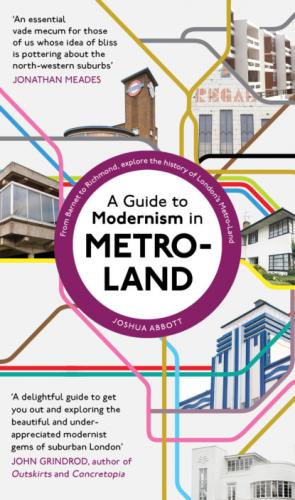A Guide to Modernism in Metro-Land. Joshua Abbott
football one side and rugby the other. T-shaped concrete ribs support the roofs of both stands and allow unimpeded views for spectators. The stand was built as part of a bigger project for Finchley Borough, which also included a lido and other facilities, now sadly demolished.
OLD RECTORY GARDENS, EDGWARE
1932
Welch, Cachemaille-Day and Lander
This small speculative estate was built opposite the recently opened Edgware tube station and was one of the first set of houses in Metro-Land, and indeed Britain, to use elements of the art deco style in housing. This synthesis between traditional house forms and deco stylings produced the ‘Sun Trap’ style that quickly spread throughout suburbia. The new elements – white walls, decorative ironwork, curved windows (the sun trap) – lent these new houses a slightly Continental glamour while still embodying the stout principles of British houses: ‘no flat roofs here, please’.
ASHLEY LANE
1933
Welch, Cachemaille-Day and Lander
NW4 1HH
WHITE HOUSE, DOWNAGE
1935 Grade II
Evelyn Simmons
NW4 1HP
A group of flat-roofed houses in Ashley Road and Sherwood Road in Hendon by Welch, Cachemaille-Day and Lander, now sadly much changed. The houses were similar to some of those by the firm on the Hanger Hill estate (see Ealing here), boxy homes in brick with sunroofs and balconies. The most spectacular of the group, No. 54, known as ‘Everest’, had a curved staircase tower, nautical-style balconies with railings and a sweeping driveway, now unfortunately demolished. One street over is the White House, a striking, Grade II-listed design in white render, with the same components of staircase tower, Crittall windows and sunroof.
BARNET ODEON
1935 Grade II
Edgar Simmons
Art deco cinema on the Great North Road in Barnet, which opened in May 1935 and remarkably still operates as a cinema (now for the Everyman chain). Designed in the Moorish style by Edgar Simmons, the interior features green marble columns, a balconied auditorium and Cubist-influenced light fittings. In the street behind, Rayden Road, are a number of speculative semi-detached flat-roofed houses dating from the same time as the cinema.
28 SPENCER DRIVE
1934
Welch, Cachemaille-Day and Lander
N2 0QX
LYTTON CLOSE
1935 Grade II
G. G. Winbourne
N2 0RH
Hampstead Garden Suburb was founded in 1906 by Henrietta Barnett as one of many planned communities that sprang up in the first part of the twentieth century, and its architecture is heavily influenced by the arts and crafts designs of its planners Barry Parker and Raymond Unwin. There are, however, a number of modernist-influenced houses within its borders. 28 Spencer Drive is a white-rendered, flat-roofed house by Welch, Cachemaille-Day and Lander, with a pantile-edged parapet. The houses in Lytton Close were designed by G. G. Winbourne in a restrained art deco style with curved suntrap windows, glazed staircase towers and sunroofs. There are a number of other modernist houses in the suburb by the likes of Ernst Freud (Neville Road) and Michael Manser (Byron Drive), but many are well hidden by hedges and fences.
HIGHFIELD COURT
1935
A. V. Pilichowski
International Style modernist apartment block in Golders Green, which due to its white starkness stands out from the more timid deco-influenced blocks in the neighbourhood. The building, designed by A. V. Pilichowski, is an L-shaped three-storey block with fourteen flats, featuring a sunken garden on one side. Pilichowski was a Polish–Jewish émigré architect who also collaborated with Berthold Lubetkin on a row of houses in Plumstead. Like many refugees from Europe he anglicised his name, becoming Vivien Pilley during World War II.
2 GOLDERS GREEN ROAD
1936
Ernő Goldfinger
One of Ernő Goldfinger’s obscurer buildings, 2 Golders Green Road was originally designed in 1935 as a hairdressing salon, but was converted into a shop for S. Weiss ladies’ clothing. Situated on a corner of the high street, Goldfinger planned the redesign and rebuild of this site to include a curved glass second floor. Goldfinger also redesigned the interior of the shop and its fittings. Despite now being widely known for his brutalist tower blocks, Goldfinger designed a number of shop interiors during the 1930s.
JOHN KEBLE CHURCH
1936 Grade II
D. F. Martin-Smith
HENDON METHODIST CHURCH
1937
Welch and Lander
Two modernist-influenced churches built in the interwar period. John Keble Memorial is just off the M1 motorway in Edgware, and was designed by D. F. Martin-Smith, who won the Edward Maufe-judged competition to build it. The building has a square church tower and is constructed of yellow London stock brick around a reinforced concrete frame, and a ceiling formed
